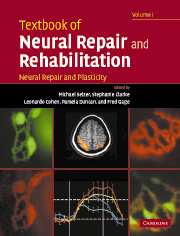Book contents
- Frontmatter
- Contents
- Contents (contents of Volume II)
- Preface
- Contributors (contributors of Volume I)
- Contributors (contributors of Volume II)
- Neural repair and rehabilitation: an introduction
- Section A Neural plasticity
- Section A1 Cellular and molecular mechanisms of neural plasticity
- 1 Anatomical and biochemical plasticity of neurons: regenerative growth of axons, sprouting, pruning, and denervation supersensitivity
- 2 Learning and memory: basic principles and model systems
- 3 Short-term plasticity: facilitation and post-tetanic potentiation
- 4 Long-term potentiation and long-term depression
- 5 Cellular and molecular mechanisms of associative and nonassociative learning
- Section A2 Functional plasticity in CNS system
- Section A3 Plasticity after injury to the CNS
- Section B1 Neural repair
- Section B2 Determinants of regeneration in the injured nervous system
- Section B3 Promotion of regeneration in the injured nervous system
- Section B4 Translational research: application to human neural injury
- Index
3 - Short-term plasticity: facilitation and post-tetanic potentiation
from Section A1 - Cellular and molecular mechanisms of neural plasticity
Published online by Cambridge University Press: 05 March 2012
- Frontmatter
- Contents
- Contents (contents of Volume II)
- Preface
- Contributors (contributors of Volume I)
- Contributors (contributors of Volume II)
- Neural repair and rehabilitation: an introduction
- Section A Neural plasticity
- Section A1 Cellular and molecular mechanisms of neural plasticity
- 1 Anatomical and biochemical plasticity of neurons: regenerative growth of axons, sprouting, pruning, and denervation supersensitivity
- 2 Learning and memory: basic principles and model systems
- 3 Short-term plasticity: facilitation and post-tetanic potentiation
- 4 Long-term potentiation and long-term depression
- 5 Cellular and molecular mechanisms of associative and nonassociative learning
- Section A2 Functional plasticity in CNS system
- Section A3 Plasticity after injury to the CNS
- Section B1 Neural repair
- Section B2 Determinants of regeneration in the injured nervous system
- Section B3 Promotion of regeneration in the injured nervous system
- Section B4 Translational research: application to human neural injury
- Index
Summary
Summary
Fast point-to-point communication between neurons in the brain is mediated by chemical synaptic transmission. During brief trains of action potentials (APs) in a presynaptic neuron, the response in the postsynaptic cell will not follow with equal strength. Rather, processes of short-term plasticity will decrease the amplitude of postsynaptic potentials (PSPs) during short-term depression, or increase PSP amplitudes, as occurs during shortterm enhancement (STE) of synaptic transmission. Various phases of STE can be distinguished based on their kinetics of decay after brief trains of presynaptic activity: Facilitation, augmentation and posttetanic potentiation. STE of synaptic transmission is induced by a rise of Ca2+ in presynaptic nerve terminals, and represents an increased number of vesicles which fuse in response to a presynaptic AP. Facilitation, which decays within less than half a second, is the shortest form of Ca2+-induced plasticity identified so far. STE and synaptic depression can be expressed simultaneously at a synapse, but the degree, and the direction of short-term plasticity is specifically regulated at a given type of synapse, and subject to modulation during postnatal development. This chapter discusses the presynaptic, Ca2+-dependent mechanisms of STE of synaptic transmission.
Overview of chemical synaptic transmission
Synaptic transmission takes place at specialized contact sites, at which the active zone of the presynaptic neuron approaches the postsynaptic density of a postsynaptic neuron (Fig. 3.1). Transmission is initiated when an action potential (AP) arrives at the nerve terminal, where it opens voltage-gated Ca2+ channels.
Keywords
- Type
- Chapter
- Information
- Textbook of Neural Repair and Rehabilitation , pp. 44 - 59Publisher: Cambridge University PressPrint publication year: 2006

